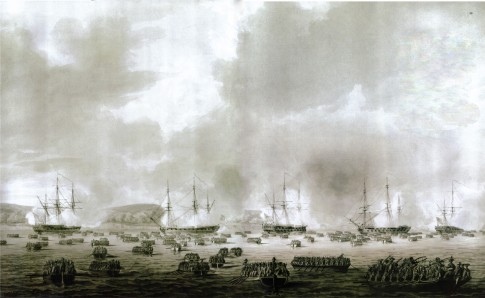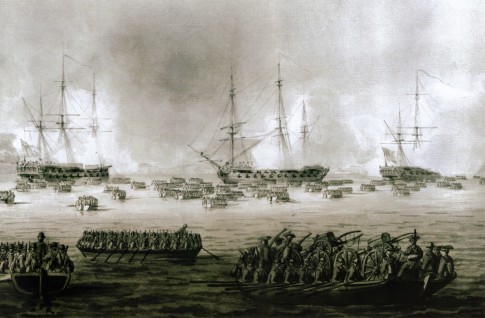THE OCCUPATION OF NEWPORT, 9 DECEMBER 1776
By Robert Cleveley, 1777
(Highest resolution available 8165×5030)
In 1775 the 13 British colonies in North America rebelled against British rule and formally proclaimed their independence as the United States of America. What started as a war for America soon became a war for global maritime predominance. It differed in a number of significant factors from the Seven Years War, however. Firstly, Spain allied with France in 1779 and their combined navies were larger than that of the British. Secondly, the maritime war was conducted in Americas, thousands miles away from any quality dockyard resources. The Royal Navy’s successes in the Western Approaches in the Seven Years War had been largely achieved through easy access to the high-quality dockyards of the south and southwest coast of Britain. Crucially these had dry docks where the ships’ bottoms could be maintained and cleaned. In the coming war, however, that advantage was lost. Moreover, the War of American Independence came after nearly a decade of peace. In peacetime the ships had been laid up and the sailors and officers laid off, but to practise naval warfare at a high level required constant practice. Efficient sail handling and gunnery required crews to be drilled regularly; maneuvering the fleet required months of practice of each captain was to be able to regulate his position in relation to others be eye; and the repair pf damage caused by enemy fire or the weather was another skill that could be learned in dock. With no explicit and detailed policy to maintain operational effectiveness, rustiness had grown in Britain as quickly as complacency. The French and Spanish, meanwhile, had been steadily growing and modernizing their navies. In the coming war the Royal Navy was to receive a terrible shock.
THE OCCUPATION OF NEWPORT, 9 DECEMBER 1776. (Fragment)
When the war came, the Royal Navy used its experience in successful amphibious assaults of the previous war, among others, Québec and Havana to attack the rebels in their heartland. New York was a rebel stronghold and the most important commercial center in North America. To provide and alternative naval base to New York, Newport, Rhode Island, was also targeted, and the landing is shown in this image. The artist, Robert Cleveley, was an eyewitness to the assault, serving as captain’s clerk aboard the Asia. Both the attacks on New York and Rhode Island were great successes. The ships in the background can be seen laying down a covering bombardment while the boats pull for the beach. The boats in this image were specially designed landing craft known as ‘flatboats’. They could be stacked on board troopships, and once assembled and launched they could carry two rows of troops facing inward down the center, or artillery as is shown in the foreground to the right.


